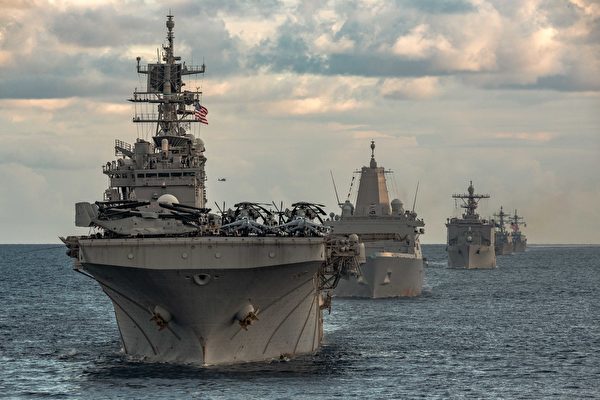The latest aircraft carrier of the United States Navy, the “USS Gerald R. Ford,” may be the most powerful aircraft carrier in history. This magnificent warship boasts the best of everything in its class, from its flight deck and software-controlled electromagnetic catapults to its next-generation nuclear power system, along with numerous other high-tech capabilities, leaving the Chinese “Fujian” aircraft carrier far behind.
The “USS Ford” aircraft carrier completed its first global deployment in the Mediterranean earlier this year, marking a milestone for the U.S. Navy.
For the past fifty years, the Nimitz class aircraft carriers have played a dominant role in the U.S. military’s power projection strategy. From top speed to formidable endurance, the Nimitz class excels in many aspects over its predecessors. While the Nimitz class can launch aircraft to strike targets hundreds of miles away, its ability to adapt to new technologies is limited. The Ford class was specifically developed by the U.S. Navy to integrate future capabilities.
The “USS Ford” aircraft carrier, the lead ship of the Ford class, entered service in 2017. The second Ford-class carrier, the “USS John F. Kennedy,” is expected to be commissioned next year, followed by the “USS Enterprise” and “USS Doris Miller,” among others. These future Ford-class carriers will replace the current Nimitz class carriers in the U.S. Navy fleet.
The Ford-class aircraft carriers are 1,092 feet long with a width of 134 feet, featuring a flight deck width of 256 feet.
Unlike the Ford class, the Fujian carrier does not use nuclear power, leading to lower endurance and smaller onboard aviation fuel storage capacity.
Equipped with advanced technologies such as electromagnetic aircraft launching systems, ship self-defense systems, and advanced arresting gear, the Ford class can launch 160 aircraft sorties per day compared to the Nimitz class’s 140 sorties.
The Ford class carriers were designed with allocated weight and stability space to accommodate the additional weight of installing new systems over their half-century service life. The carriers feature advanced weapons elevators utilizing new technologies like electromagnetic motors and hydraulic systems, requiring fewer sailors for safe munitions transport, unparalleled speed, and agility.
In terms of weaponry and air power, the Ford class surpasses its counterparts. Each carrier will be equipped with Raytheon’s upgraded “Sea Sparrow” missiles and close-defense weapon systems, capable of deploying 90 aircraft including standout models like the F-35 “Lightning II,” F/A-18E/F “Super Hornet,” EA-18G “Growler” electronic warfare aircraft, and E-2D “Advanced Hawkeye” early warning aircraft. Additionally, numerous unmanned aerial vehicles and combat vehicles will be integrated.
The Chinese Fujian carrier, weighing 80,000 tons, surpasses its predecessors the 60,000-ton “Liaoning” and 66,000-ton “Shandong,” but the USS Ford carrier displaces around 100,000 tons with a higher number of onboard aircraft.
While the Fujian carrier recently completed its first sea trial, the USS Ford has undergone a five-year sea trial since 2017 and debuted its first deployment in November 2022.
The Chinese aircraft carriers typically operate near shore and seldom venture beyond the first island chain (the coastlines of East Asia extending east from the Japanese islands to the waters near the Philippines). This is not surprising considering most of these waters are surrounded by neighboring countries’ weapon zones. In contrast, the U.S. deploys carriers globally, accumulating extensive experience.
In May 2023, the “USS Ford” led a carrier strike group (GRF CSG) to Europe in response to heightened tensions in the Middle East, serving as a strong symbol of U.S. support. The group comprised eight attack and support aircraft squadrons, the Ticonderoga-class guided-missile cruiser “USS Normandy,” and four Arleigh Burke-class guided-missile destroyers.
After 244 days, the “USS Ford” returned to its homeport in the United States, achieving a milestone by not only completing its initial mission but also stabilizing the situation in conflict areas.
The Fujian carrier represents China’s military ambitions for modernization, though advanced over its predecessors, it lacks the comprehensive support systems comparable to the U.S. Navy, as highlighted by the Lowy Institute’s International Security Program Director Sam Roggeveen.
“One weakness is that China lacks the infrastructure to operate the Fujian carrier far from its home waters over extended periods. It has only a small fleet of replenishment vessels that typically accompany carrier groups to provide fuel, ammunition, and supplies,” Roggeveen told Newsweek.
A crucial aspect of global maritime operations involves establishing base networks and port access agreements with friendly countries. Western fleets leverage foreign ports to extend operational range and maintain a forward presence. Thus, the U.S. possesses a more extensive global maritime infrastructure network enabling carriers to utilize these advantages.
“China does not have the vast global network of ports and bases that the U.S. has, where carriers can refuel and crews can rest,” Roggeveen noted.
China’s military facility in Djibouti is its sole overseas base, primarily utilized by a small number of Middle East task force ships regularly.
Furthermore, Western navies consider building partnerships fundamental to their maritime strategies in all regions. The U.S. Navy prioritizes multilateral maritime partnerships in the Indo-Pacific region, strengthening these relationships through exchanges, exercises, joint operations, and industry cooperation, an aspect currently lacking in China.
The successful first deployment of the “USS Ford” aircraft carrier marks a significant advancement for the Navy’s new carrier class. As geopolitical tensions escalate, the undeniable importance of the vast and cutting-edge U.S. carrier fleet will continue to prove itself as a critical and necessary asset.

